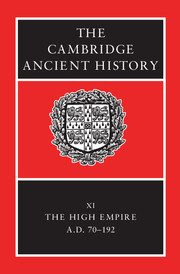Crossref Citations
This Book has been
cited by the following publications. This list is generated based on data provided by Crossref.
Clark, Gillian
2004.
Christianity and Roman Society.
2005.
A Companion to Latin Literature.
p.
406.
Scheidel, Walter
Morris, Ian
and
Saller, Richard P.
2007.
The Cambridge Economic History of the Greco-Roman World.
France, Jérôme
2009.
Rome et l’Occident.
p.
141.
2009.
Building Cycles.
p.
394.
2010.
A Companion to Families in the Greek and Roman Worlds.
p.
567.
Stroia, L
Georgescu, S C
and
Georgescu, A M
2010.
Antiquity versus modern times in hydraulics – a case study.
IOP Conference Series: Earth and Environmental Science,
Vol. 12,
Issue. ,
p.
012097.
Silva, Filipe
2013.
Memória, Principado e Adriano na Vita Divi Augusta de Suetônio.
Revista de Estudos Filosóficos e Históricos da Antiguidade,
Vol. 14,
Issue. 26,
p.
23.
2013.
The Rise of Gay Rights and the Fall of the British Empire.
p.
40.
Pelling, Christopher
2013.
A Companion to Plutarch.
p.
149.
Heesch, Johan van
2014.
De l'or pour les braves !.
p.
139.
Łoś, Andrzej
and
Pietruszka, Wojciech
2016.
Le vignoble campanien sous les Antonins.
Mélanges de l'École française de Rome. Antiquité,
Pollard, Nigel
2016.
The Encyclopedia of Empire.
p.
1.
Spinelli, Tommaso
and
Gregori, Gian Luca
2019.
(Un)-damning Subplots: The Principate of Domitian Between Literary Sources and Fresh Material Evidence.
Illinois Classical Studies,
Vol. 44,
Issue. 2,
p.
242.
Wiryomartono, Bagoes
2020.
Livability and Sustainability of Urbanism.
p.
17.
Ando, Clifford
2021.
Empire and Religion in the Roman World.
p.
71.



